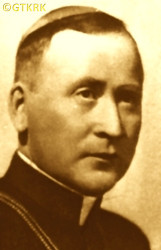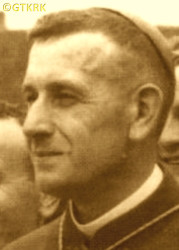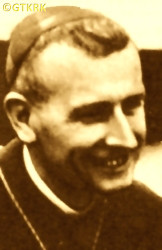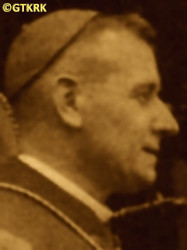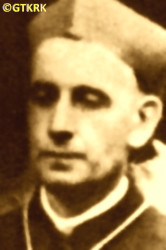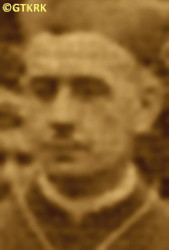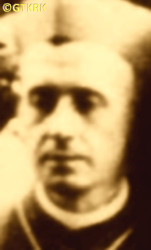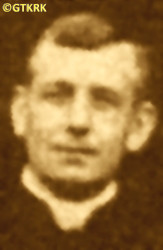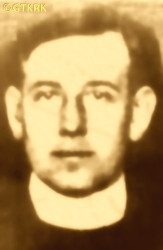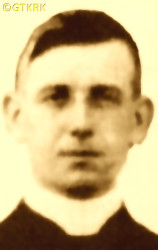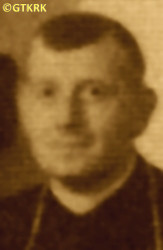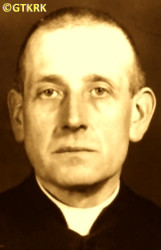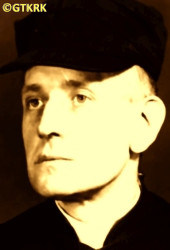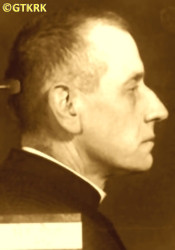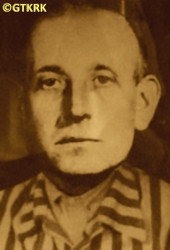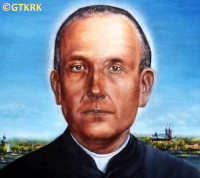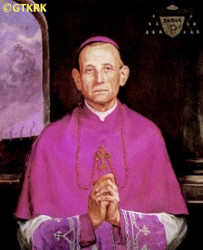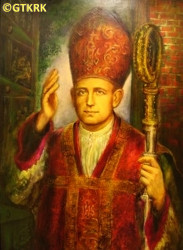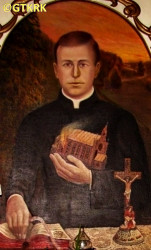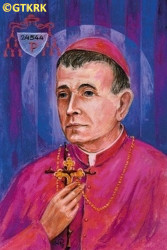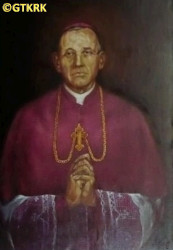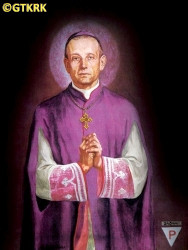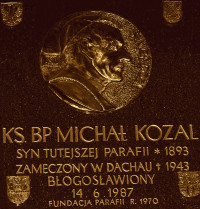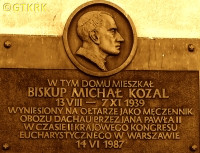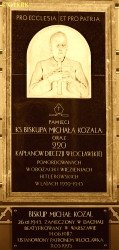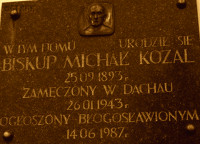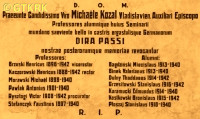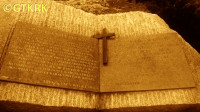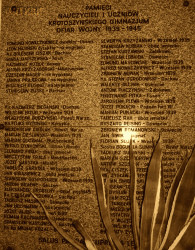Roman Catholic
St Sigismund parish
05-507 Słomczyn
85 Wiślana Str.
Konstancin deanery
Warsaw archdiocese, Poland
full list:
displayClick to display full list

searchClick to search full list by categories
wyświetlKliknij by wyświetlić pełną listę po polsku

szukajKliknij by przeszukać listę wg kategorii po polsku

Martyrology of the clergy — Poland
XX century (1914 – 1989)
personal data
religious status
blessed
surname
KOZAL
forename(s)
Michael (pl. Michał)
function
bishop
creed
Latin (Roman Catholic) Church RCmore on
en.wikipedia.org
[access: 2014.09.21]
diocese / province
Włocławek diocesemore on
en.wikipedia.org
[access: 2013.05.19]
Gniezno and Poznań archdiocese (aeque principaliter)more on
www.archpoznan.pl
[access: 2012.11.23]
honorary titles
Papal chamberlainmore on
en.wikipedia.org
[access: 2014.11.22]
(1932)
date and place
of death
26.01.1943

KL Dachauconcentration camp
today: Dachau, Upper Bavaria reg., Bavaria state, Germany
more on
en.wikipedia.org
[access: 2016.05.30]
alt. dates and places
of death
23.01.1943
details of death
After German and Russian invasion of Poland in 09.1939 and start of the World War II, after start of German occupation, arrested by the Germans on 07.11.1939, together with Włocławek's priests, 9 professors and 22 students of theological seminary.
Jailed in Włocławek prison.
From 16.01.1940 jailed in IL Lond transit camp in Ląd.
Next on 03.04.1941 moved to Inowrocław transit camp where was severely beaten by German guards.
From there moved to Berlin prison where was incarcerated during Easter 13‐14.04.1941.
Finally on 25.04.1941 transported — via Halle, Weimer and Nürenburg — to KL Dachau concentration camp.
There fell seriously ill with ear Infection (Lat. otitis media). The witness remembered: „Because it was slippery and the Bishop was wearing wooden clogs, one time he slipped and fell so badly that at the same moment the cauldron opened and hot soup spilled on him. He suffered burns. And as if that was not enough, the kapo who was carrying the cauldrons jumped at him and hit him so hard in the ear that the Bishop fell down a second time and began to bleed. Blood was pouring from his nose and ear. From that time on […] he suffered from a severe, almost unbearable headache, also in his ears”.
At the order of the supreme German authorities, in order to „not create martyrs” — according to the unofficial national–socialist policy — transferred to a block of patients suffering from typhus (an epidemic of abdominal typhus — typhoid fever — was spreading in the camp).
There murdered with an injection of phenol via his hand. The witness described the last moments of his life as follows: „Suddenly three men approached him: two in uniforms and one in a white doctor's coat. A nurse immediately rushed to meet them. They asked him something and when he answered, they headed to the Bishop's bed. One of the officers, probably a doctor, because he did most of the talking, demanded a fever card, and the other had another card in his hand, probably a death order. They compared surnames and then one of them asked: 'What is your name?'. The Bishop replied: «I am Michał Kozal». 'Are you a bishop?'. The answer came: «I am a Roman Catholic bishop». They compared the cards again and then gave a sign to the prisoner who was in a doctor's coat. He approached and gave Bishop Kozal an injection. At the same moment a nurse friend passed by my bed. I asked: 'What's that supposed to mean?'. He replied: 'In 5 minutes you'll know what that's supposed to mean'. Everything in me was trembling, I couldn't control myself. I pulled the blanket on my bed a little and gave the Bishop the last absolution. As a several‐year camp prisoner, I had already had enough experience to know that this was a lethal injection. I was not mistaken. When those 5 minutes had passed, I heard the doctor say: 'Fertig'. That meant 'ready', or more precisely 'finished'”.
According to a copy of the „disease” file from the KL Dachau, otherwise „honest” German „doctors” and formalists — and at the same time unparalleled storytellers — noted: „26.01.1943: falls into agony and dies at 14:50”, due to Germ. „Versagen von Herz und Kreislauf, bei Typhus abdominalis” (Eng. „Heart and circulatory failure, due to typhoid fever”).
prisoner camp's numbers
24544Click to display source page (KL DachauClick to display the description)
cause of death
murder
perpetrators
Germans
sites and events
KL DachauClick to display the description, Berlin (Moabit)Click to display the description, InowrocławClick to display the description, IL LondClick to display the description, WłocławekClick to display the description, Reichsgau WarthelandClick to display the description, «Intelligenzaktion»Click to display the description, Ribbentrop‐MolotovClick to display the description, Pius XI's encyclicalsClick to display the description
date and place
of birth
25.09.1893Birth certification on:
photos.szukajwarchiwach.gov.pl
[access: 2025.03.07]

Nowy Folwarktoday: Krotoszyn gm., Krotoszyn pov., Greater Poland voiv., Poland
more on
en.wikipedia.org
[access: 2021.12.18]
parents
KOZAL John
🞲 ?, ? — 🕆 1918, ?

PŁACZEK Mary
🞲 1851, ? — 🕆 02.1927, Bydgoszcztoday: Bydgoszcz city pov., Kuyavia‐Pomerania voiv., Poland
more on
en.wikipedia.org
[access: 2021.06.20]
baptism
30.09.1893Birth certification on:
photos.szukajwarchiwach.gov.pl
[access: 2025.03.07]

Krotoszyntoday: Krotoszyn gm., Krotoszyn pov., Greater Poland voiv., Poland
more on
en.wikipedia.org
[access: 2021.07.18]
St John the Baptist RC church
presbyter (holy orders)
ordination
23.02.1918

Gnieznotoday: Gniezno urban gm., Gniezno pov., Greater Poland voiv., Poland
more on
en.wikipedia.org
[access: 2021.12.18]
Assumption of the Blessed Virgin Mary RC archcathedral churchmore on
en.wikipedia.org
[access: 2025.03.14]
positions held
1939 – 1943
titular bishop — Lappa RC diocese — appointment: on 10.06.1939; ordination: on 13.08.1939, Assumption of the Blessed Virgin Mary cathedral in Włocławek
1939 – 1943
auxiliary bishop (Lat. episcopus auxiliaris) — Włocławek RC diocese — appointment: on 10.06.1939
1929 – 1939
rector — Gnieznotoday: Gniezno urban gm., Gniezno pov., Greater Poland voiv., Poland
more on
en.wikipedia.org
[access: 2021.12.18] ⋄ Archbishop's Theological Seminary
1932 – 1939
visitor / inspector of religion education — schools ⋄ Gniezno RC archdiocese
1927 – 1929
professor — Gnieznotoday: Gniezno urban gm., Gniezno pov., Greater Poland voiv., Poland
more on
en.wikipedia.org
[access: 2021.12.18] ⋄ fundamental theology, Archbishop's Theological Seminary
1927 – 1929
spiritual father — Gnieznotoday: Gniezno urban gm., Gniezno pov., Greater Poland voiv., Poland
more on
en.wikipedia.org
[access: 2021.12.18] ⋄ Archbishop's Theological Seminary
pro‐synodal judge — Gniezno RC archdiocese
censor of religious books (Lat. censores librorum) — Gniezno RC archdiocese
1923 – 1927
prefect — Bydgoszcztoday: Bydgoszcz city pov., Kuyavia‐Pomerania voiv., Poland
more on
en.wikipedia.org
[access: 2021.06.20] ⋄ City Catholic gymnasium for Women ⋄ St Martin and St Nicholas the Bishops and Confessors RC parish (main parish) ⋄ Bydgoszcztoday: Bydgoszcz city pov., Kuyavia‐Pomerania voiv., Poland
more on
en.wikipedia.org
[access: 2021.06.20] RC deanery
1920 – 1923
curatus/rector/expositus — Krostkowotoday: Białośliwie gm., Piła pov., Greater Poland voiv., Poland
more on
en.wikipedia.org
[access: 2020.11.01] ⋄ St Nicholas the Bishop and Confessor RC church ⋄ Kosztowotoday: Wyrzysk gm., Piła pov., Greater Poland voiv., Poland
more on
en.wikipedia.org
[access: 2021.12.19], St Anne RC parish ⋄ Nakło nad Noteciątoday: Nakło nad Notecią gm., Nakło nad Notecią pov., Kuyavia‐Pomerania voiv., Poland
more on
en.wikipedia.org
[access: 2020.11.27] RC deanery
1920
vicar — Pobiedziskatoday: Pobiedziska gm., Poznań pov., Greater Poland voiv., Poland
more on
en.wikipedia.org
[access: 2020.11.01] ⋄ St Michael the Archangel RC parish ⋄ Pobiedziskatoday: Pobiedziska gm., Poznań pov., Greater Poland voiv., Poland
more on
en.wikipedia.org
[access: 2020.11.01] RC deanery
1918 – 1920
vicar — Kościelecalso: Kościelec Kujawski
today: Pakość gm., Inowrocław pov., Kuyavia‐Pomerania voiv., Poland
more on
en.wikipedia.org
[access: 2020.11.01] ⋄ St Margaret the Virgin and Martyr RC parish ⋄ Inowrocławtoday: Inowrocław gm., Inowrocław pov., Kuyavia‐Pomerania voiv., Poland
more on
en.wikipedia.org
[access: 2021.07.18] RC deanery
till 1918
student — Gnieznotoday: Gniezno urban gm., Gniezno pov., Greater Poland voiv., Poland
more on
en.wikipedia.org
[access: 2021.12.18] ⋄ philosophy and theology, Archbishop's Practical Theological Seminary (Lat. Seminarium Clericorum Practicum)
from 1914
student — Poznańtoday: Poznań city pov., Greater Poland voiv., Poland
more on
en.wikipedia.org
[access: 2021.07.18] ⋄ philosophy and theology, Archbishop's Theological Seminary (Collegium Leoninum)
others related
in death
BRZUSKIClick to display biography Henry, DEMBCZYKClick to display biography Sylvain, KACZOROWSKIClick to display biography Henry Sigismund, STRASZEWSKIClick to display biography Joseph, URBAŃSKIClick to display biography Andrew
sites and events
descriptions
KL Dachau: KL Dachau in German Bavaria, set up in 1933, became the main German Germ. Konzentrationslager (Eng. concentration camp) KL for Catholic priests and religious during World War II: On c. 09.11.1940, Reichsführer‐SS Heinrich Himmler, head of the SS, Gestapo and German police, as a result of the Vatican's intervention, decided to transfer all clergymen detained in various concentration camps to KL Dachau camp. The first major transports took place on 08.12.1940. In KL Dachau Germans held approx. 3,000 priests, including 1,800 Poles. The priests were forced to slave labor in the Germ. „Die Plantage” — the largest herb garden in Europe, managed by the genocidal SS, consisting of many greenhouses, laboratory buildings and arable land, where experiments with new natural medicines were conducted — for many hours, without breaks, without protective clothing, no food. They slaved in construction, e.g. of camp's crematorium. In the barracks ruled hunger, freezing cold in the winter and suffocating heat during the summer, especially acute in 1941‐1942. Prisoners suffered from bouts of illnesses, including tuberculosis. Many were victims of murderous „medical experiments” — in 11.1942 c. 20 were given phlegmon injections; in 07.1942 to 05.1944 c. 120 were used by for malaria experiments. More than 750 Polish clerics where murdered by the Germans, some brought to TA Hartheim euthanasia centre set up in Schloss Hartheim in Austria and murdered in gas chambers. At its peak KL Dachau concentration camps’ system had nearly 100 slave labour sub‐camps located throughout southern Germany and Austria. There were c. 32,000 documented deaths at the camp, and thousands perished without a trace. C. 10,000 of the 30,000 inmates were found sick at the time of liberation, on 29.04.1945, by the USA troops… (more on: www.kz-gedenkstaette-dachau.deClick to attempt to display webpage
[access: 2013.08.10], en.wikipedia.orgClick to attempt to display webpage
[access: 2016.05.30])
Berlin (Moabit): Prison in Berlin at Lehrter Straße, called Germ. Zellengefängnis (Eng. Cell prison), constructed in 1842‐1849 by the order of Frederic William IV, King of Prussia. During World War II German army Wehrmacht remand prison, and next German political police Gestapo prison. Place of execution including by beheading. Place of death of many Poles. Shut down in 1957‐1958. (more on: en.wikipedia.orgClick to attempt to display webpage
[access: 2019.11.17])
Inowrocław: German prison and detention center at Pakoska Str. (today Narutowicza Str.). In 1939, the Germans held there hundreds of Poles from Inowrocław and the surrounding area, arrested as part of the «Intelligenzaktion» program — the physical extermination of the Polish intelligentsia and leadership classes. By 11.1939, 546 of them were murdered in the prison and the surrounding area (e.g. in Rożniaty and Zajezierze), including 56 people on the night of 22‐23.10.1939, the murder carried out after the collective libation of the Germans, which the German landrat, i.e. the occupying district official, a certain Hirschfeld, was said to have initiated by saying: „well, now we will go and shoot the Poles”. Later, it was also a place of execution for many Poles. After the Russian occupation began in 1945, the communist prison, also for women. (more on: www.inowroclawfakty.plClick to attempt to display webpage
[access: 2013.05.19])
IL Lond: The Gestapo District Office in Poznań issued on 13.12.1939 executive instruction Ref. IIB No. 406/39 Tgb. No. 3045/39, ordering: „Based on the regulation of the Germ. Höherer SS‐ und Polizeiführer (Eng. Higher Commander of the SS and Police) [of the German province of Warthegau (Eng. Greater Poland)] of 12.11.1939 [SS‐Gruppenführer Wilhelm Koppe], apart from Poles and Jews, also Catholic clergy will be expelled. Action against this group of people should be carried out in such a way that internment and transport are separate […] C. 80% of Catholic clergy are expected to be expelled. The selection based on political threat posed. Internees cannot be placed in regular transit camps due to the possibility of international protest. Catholic clergy should be interned in men's monasteries and held there till mass transportation out”. And so in 1940‐1941, in a formerly Cistercian priory and monastery (today Salesian Institute) in Ląd on Warta river Germans set‐up a transit Germ. „Internierungslager” (Eng. „Internment camp”) for Polish priests and religious, from Włocławek, Gniezno, Warszawa, Poznań, Płock and Częstochowa dioceses and religious and monks from a number of congregations. Approx. 152 religious (70 till 03.04.1941 and 82 in 06‐28.10.1941) were held there prior to being sent to KL Dachau concentration camp. After the deportation, the Germans organized a training center for the German National Socialist youth wing, Germ. „Hitler‐Jugend” (Eng. „Hitler youth”), in the abbey. (more on: pl.wikipedia.orgClick to attempt to display webpage
[access: 2013.08.10], yadda.icm.edu.plClick to attempt to display webpage
[access: 2016.03.14])
Włocławek: Police detention centre at Karnkowski Str. in downtown Włocławek run by Germans. In 1939‐1940 Germans held there hundreds of Poles, including dozens of Polish priests, that were subsequently transported to German concentration camps. (more on: www.sztetl.org.plClick to attempt to display webpage
[access: 2017.01.21])
Reichsgau Wartheland: After the Polish defeat in the 09.1939 campaign, which was the result of the Ribbentrop‐Molotov Pact and constituted the first stage of World War II, and the beginning of German occupation in part of Poland (in the other, eastern part of Poland, the Russian occupation began), the Germans divided the occupied Polish territory into five main regions (and a few smaller). The largest one was transformed into Germ. Generalgouvernement (Eng. General Governorate), intended exclusively for Poles and Jews and constituting part of the so‐called Germ. Großdeutschland (Eng. Greater Germany). Two were added to existing German provinces. From two other separate new provinces were created. Greater Poland region was one of them, incorporated into Germany on 08.10.1939, by decree of the German leader Adolf Hitler (formally came into force on 26.10.1939), and on 24.01.1940 transformed into the Germ. Reichsgau Wartheland (Eng. Wartheland Reich Province), in which the law of the German state was to apply. The main axis of the policy of the new province, the territory of which the Germans recognized as the Germ. „Ursprünglich Deutsche” (Eng. „natively German”), despite the fact that 90% of its inhabitants were Poles, was Germ. „Entpolonisierung” (Eng. „Depolonisation”), i.e. forced Germanization. C. 100,000 Poles were murdered as part of the Germ. „Intelligenzaktion”, i.e. extermination of Polish intelligentsia and ruling classes. C. 630,000 were forcibly resettled to the Germ. Generalgouvernement, and their place taken by the Germans brought from other areas occupied by Germany (e.g. the Baltic countries, Bessarabia, Bukovina, etc.). Poles were forced to sign the German nationality list, the Germ. Deutsche Volksliste DVL. As part of the policy of „Ohne Gott, ohne Religion, ohne Priesters und Sakramenten” (Eng. „No God, no religion, no priest or sacrament”) most Catholic priests were arrested and sent to concentration camps. All schools teaching in Polish, Polish libraries, theaters and museums were closed. Polish landed estates confiscated. To further reduce the number of the Polish population, Poles were sent to forced labor deep inside Germany, and the legal age of marriage for Poles was increased (25 for women, 28 for men). The German state office, Germ. Rasse‐ und Siedlungshauptamt (Eng. Main Office of Race and Settlement) RuSHA, under the majesty of German law, abducted several thousand children who met specific racial criteria from Polish families and subjected them to forced Germanization, handing them over to German families. After the end of hostilities of World War II, the overseer of this province, the Germ. Reichsstatthalter (Eng. Reich Governor) and the Germ. Gauleiter (Eng. district head) of the German National Socialist Party, Arthur Karl Greiser, was executed. (more on: en.wikipedia.orgClick to attempt to display webpage
[access: 2024.06.21])
«Intelligenzaktion»: German: «Intelligenzaktion» (English: „Intelligence Action”) — a German program of extermination of the Polish elite, mainly the intelligentsia and leadership layers, carried out from the beginning of the occupation in w 09.1939 to 04.1940, mainly in territories directly annexed to Germany, but also in the so‐called Germ. Generalgouvernement (Eng. General Governorate), where it was called «AB‐aktion». In the first phase, immediately after the beginning of the German occupation, during military operations carried out by the Germ. Wehrmacht (Eng. Armed Forces) and the genocidal units of the Germ. Einsatzgruppen (Eng. Operational Groups) of the Germ. Sicherheitspolizei (Eng. Security Police), i.e. SiPo, and Germ. Sicherheitsdienst des Reichsführers SS (Eng. Security Service of the Reichsführer SS), i.e. SD, organized by the Germ. Reichssicherheitshauptamt (Eng. Reich Main Security Office), i.e. RSHA, which followed the troops, carried out under the Germ. Unternehmen „Tannenberg” (Eng. Operation „Tannenberg”) — based on the so‐called Germ. Sonderfahndungsliste (Eng. Special Wanted Lists), i.e. proscription lists of Poles considered particularly dangerous to the Third Reich, prepared by the Zentralstelle II/P (Polen) unit of the German RSHA. Later, implemented by the German civilian occupation authorities and the genocidal unit of the Germ. Volksdeutscher Selbstschutz (Eng. Ethnic Germans Self‐Defense), whose members were Germ. Volksdeutsche (Eng. Ethnic Germans), i.e. representatives of the German minority in Poland. According to various sources, these lists, at the beginning of 09.1939, could have contained the details of 61,000—88,000 „dangerous” Poles — although these figures cannot be confirmed. In total, during this genocide, c. 50,000 teachers, Catholic priests, representatives of the landed gentry, freelancers, social and political activists, and retired military personnel were systematically and methodically murdered. Another 50,000 were sent to concentration camps, where only a negligible percentage survived. (more on: en.wikipedia.orgClick to attempt to display webpage
[access: 2014.10.04])
Ribbentrop‐Molotov: Genocidal Russian‐German alliance pact between Russian leader Joseph Stalin and German leader Adolf Hitler signed on 23.08.1939 in Moscow by respective foreign ministers, Mr. Vyacheslav Molotov for Russia and Joachim von Ribbentrop for Germany. The pact sanctioned and was the direct cause of joint Russian and German invasion of Poland and the outbreak of the World War II in 09.1939. In a political sense, the pact was an attempt to restore the status quo ante before 1914, with one exception, namely the „commercial” exchange of the so‐called „Kingdom of Poland”, which in 1914 was part of the Russian Empire, fore Eastern Galicia (today's western Ukraine), in 1914 belonging to the Austro‐Hungarian Empire. Galicia, including Lviv, was to be taken over by the Russians, the „Kingdom of Poland” — under the name of the General Governorate — Germany. The resultant „war was one of the greatest calamities and dramas of humanity in history, for two atheistic and anti‐Christian ideologies — national and international socialism — rejected God and His fifth Decalogue commandment: Thou shall not kill!” (Abp Stanislav Gądecki, 01.09.2019). The decisions taken — backed up by the betrayal of the formal allies of Poland, France and Germany, which on 12.09.1939, at a joint conference in Abbeville, decided not to provide aid to attacked Poland and not to take military action against Germany (a clear breach of treaty obligations with Poland) — were on 28.09.1939 slightly altered and made more precise when a treaty on „German‐Russian boundaries and friendship” was agreed by the same murderous signatories. One of its findings was establishment of spheres of influence in Central and Eastern Europe and in consequence IV partition of Poland. In one of its secret annexes agreed, that: „the Signatories will not tolerate on its respective territories any Polish propaganda that affects the territory of the other Side. On their respective territories they will suppress all such propaganda and inform each other of the measures taken to accomplish it”. The agreements resulted in a series of meeting between two genocidal organization representing both sides — German Gestapo and Russian NKVD when coordination of efforts to exterminate Polish intelligentsia and Polish leading classes (in Germany called «Intelligenzaktion», in Russia took the form of Katyń massacres) where discussed. Resulted in deaths of hundreds of thousands of Polish intelligentsia, including thousands of priests presented here, and tens of millions of ordinary people,. The results of this Russian‐German pact lasted till 1989 and are still in evidence even today. (more on: en.wikipedia.orgClick to attempt to display webpage
[access: 2015.09.30])
Pius XI's encyclicals: Facing the creation of two totalitarian systems in Europe, which seemed to compete with each other, though there were more similarities than contradictions between them, Pope Pius XI issued in 03.1937 (within 5 days) two encyclicals. In the „Mit brennender Sorge” (Eng. „With Burning Concern”) published on 14.03.1938, condemned the national socialism prevailing in Germany. The Pope wrote: „Whoever, following the old Germanic‐pre‐Christian beliefs, puts various impersonal fate in the place of a personal God, denies the wisdom of God and Providence […], whoever exalts earthly values: race or nation, or state, or state system, representatives of state power or other fundamental values of human society, […] and makes them the highest standard of all values, including religious ones, and idolizes them, this one […] is far from true faith in God and from a worldview corresponding to such faith”. On 19.03.1937, published „Divini Redemptoris” (Eng. „Divine Redeemer”), in which criticized Russian communism, dialectical materialism and the class struggle theory. The Pope wrote: „Communism deprives man of freedom, and therefore the spiritual basis of all life norms. It deprives the human person of all his dignity and any moral support with which he could resist the onslaught of blind passions […] This is the new gospel that Bolshevik and godless communism preaches as a message of salvation and redemption of humanity”… Pius XI demanded that the established human law be subjected to the natural law of God , recommended the implementation of the ideal of a Christian state and society, and called on Catholics to resist. Two years later, National Socialist Germany and Communist Russia came together and started World War II. (more on: www.vatican.vaClick to attempt to display webpage
[access: 2023.05.28], www.vatican.vaClick to attempt to display webpage
[access: 2023.05.28])
sources
personal:
bibliotekanauki.plClick to attempt to display webpage
[access: 2025.03.07], pl.wikipedia.orgClick to attempt to display webpage
[access: 2012.11.23], photos.szukajwarchiwach.gov.plClick to attempt to display webpage
[access: 2025.03.07], www.wtg-gniazdo.orgClick to attempt to display webpage
[access: 2012.11.23], 041940.plClick to attempt to display webpage
[access: 2013.12.27]
bibliographical:
„Victims of German crime among Włocławek diocese clergy”, Fr Stanislav Librowski, „Włocławek Diocese Chronicle”, 07‐08.1947
„International Tracing Service (ITS), Bad Arolsen, GermanyClick to display source page”, Arolsen Archives
original images:
www.szkolnictwo.plClick to attempt to display webpage
[access: 2020.09.24], www.youtube.comClick to attempt to display webpage
[access: 2021.12.19], slideplayer.plClick to attempt to display webpage
[access: 2020.09.24], slideplayer.plClick to attempt to display webpage
[access: 2020.09.24], slideplayer.plClick to attempt to display webpage
[access: 2020.09.24], misyjne.plClick to attempt to display webpage
[access: 2020.09.24], slideplayer.plClick to attempt to display webpage
[access: 2020.09.24], slideplayer.plClick to attempt to display webpage
[access: 2020.09.24], slideplayer.plClick to attempt to display webpage
[access: 2020.09.24], www.swietyjozef.kalisz.plClick to attempt to display webpage
[access: 2020.09.24], slideplayer.plClick to attempt to display webpage
[access: 2020.09.24], slideplayer.plClick to attempt to display webpage
[access: 2020.09.24], slideplayer.plClick to attempt to display webpage
[access: 2020.09.24], kosciol.wiara.plClick to attempt to display webpage
[access: 2020.09.24], biblia-swieci.plClick to attempt to display webpage
[access: 2021.12.19], kosciol.wiara.plClick to attempt to display webpage
[access: 2020.09.24], twitter.comClick to attempt to display webpage
[access: 2020.09.24], m.niedziela.plClick to attempt to display webpage
[access: 2020.09.24], ekai.plClick to attempt to display webpage
[access: 2020.09.24], www.facebook.comClick to attempt to display webpage
[access: 2021.12.19], www.facebook.comClick to attempt to display webpage
[access: 2021.12.19], slideplayer.plClick to attempt to display webpage
[access: 2020.09.24], www.obrazki.witkm.plClick to attempt to display webpage
[access: 2020.09.24], opoka.newsClick to attempt to display webpage
[access: 2020.09.24], www.przewodnik-katolicki.plClick to attempt to display webpage
[access: 2020.09.24], www.eszkola-wielkopolska.plClick to attempt to display webpage
[access: 2013.12.04], pomniki.wloclawek.plClick to attempt to display webpage
[access: 2018.11.18], pomniki.wloclawek.plClick to attempt to display webpage
[access: 2018.11.18], www.eszkola-wielkopolska.plClick to attempt to display webpage
[access: 2013.12.04], pomniki.wloclawek.plClick to attempt to display webpage
[access: 2018.11.18], pomniki.wloclawek.plClick to attempt to display webpage
[access: 2018.11.18], www.eszkola-wielkopolska.plClick to attempt to display webpage
[access: 2013.12.04]
LETTER to CUSTODIAN/ADMINISTRATOR
If you have an Email client on your communicator/computer — such as Mozilla Thunderbird, Windows Mail or Microsoft Outlook, described at WikipediaPatrz:
en.wikipedia.org, among others — try the link below, please:
LETTER to CUSTODIAN/ADMINISTRATORClick and try to call your own Email client
If however you do not run such a client or the above link is not active please send an email to the Custodian/Administrator using your account — in your customary email/correspondence engine — at the following address:

giving the following as the subject:
MARTYROLOGY: KOZAL Michael
To return to the biography press below:
 Click to return to biography
Click to return to biography








